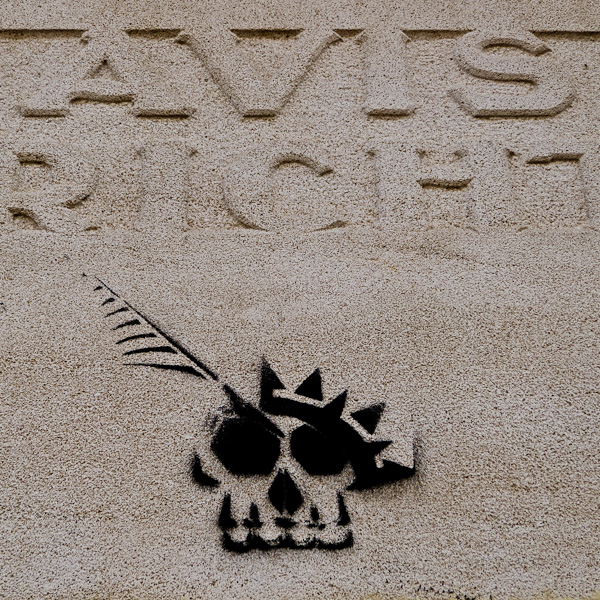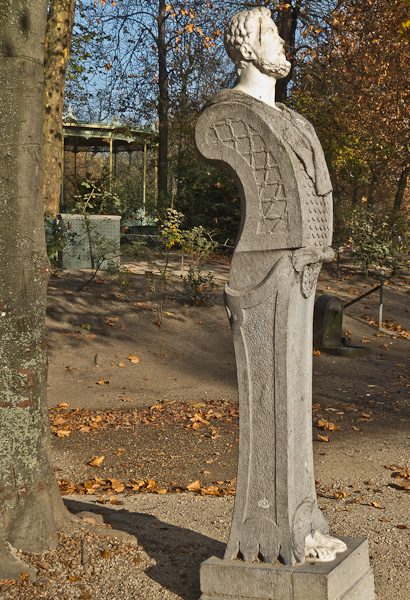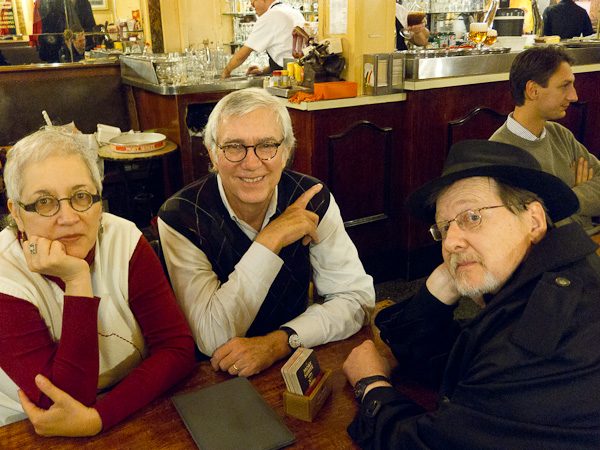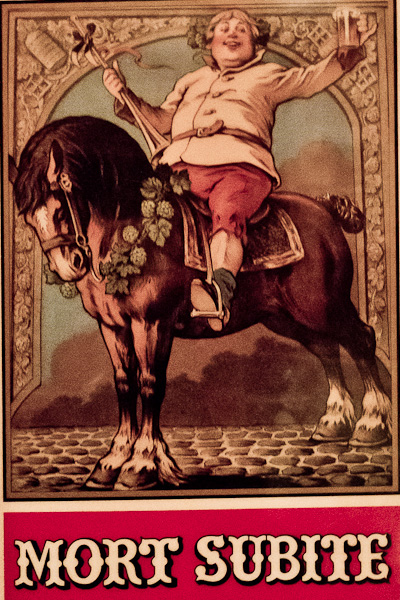Today I’ll post some more pictures of Brussels, with comments. And in the main text I’ll put some notes towards a novel I’m trying to start. The book’s title is probably The Big Aha. I’ve blogged some of this material before, but I’ve been polishing and recofinguring it, so here we go.

[“Avis” means announcement. The message of the skull.]
A certain kind of advance could lead to a discontinuous jump in ordinary human’s intelligence. I’ll be calling this advance The Big Aha.
There’s a tantalizing dream of AI workers that there may yet be some conceptual trick that we can use to make our machines really smart. The only path towards AI at present seems to be beating problems to death with evolving neural nets working on huge data-bases. We get incremental progress by making the computers faster, the neural nets more complex, and the data bases larger.
The SF dream is that there’s some new and exciting angle, a different tech, a clear and simple insight, a Big Aha?

And—the kicker—the aha would work for human brains as well as for machines. I’m in fact thinking of us finding the Big Aha for human brains, and then transferring it down to the computers. Intelligence augmentation, then artificial intelligence. Not that the AI really matters that much if we can really kick our own minds into a higher gear.
So what’s the Big Aha that I have in mind?
I’m liking the ideas having to do with quantum computation. At one point SF writers used radio as an all-purpose Maguffin, then it was radiation, then black holes, space warps, chaos theory, quarks…these days I’m liking quantum computation as a magic wand.
Every object supports a very intricate quantum computation. Think of a septillion or so particles hooked together by intricate forces, all of them vibrating. Clearly any object is a universal computer with a very rich range of readily accessible states.

[With John and Mickey Shirley in the Mort Subite (sudden death) bar in Brussels.]
Let me start thinking of my mind as a quantum computation. After all, my thoughts aren’t at all like a page of symbols—they’re blotches and rhythms and associations. Is there any communicable way to truly describe your real mental life?
Go back to the notion that your brain, like any physical object, is a quantum system. Quantum systems can evolve in two modes:
You’re in the smooth mode when you gaze idly at a menu, and you collapse to the chunky mode when when you decide what to order.

[The mascot or logo of the Mort Subite bar, the name is also a type of beer. The image is bit like the Tarot card of the Fool.]
Introspection tells me that this distinction is accurate. I do feel the continuous and the discrete modes of thought within my mind. Although, admittedly, it may not be that the sensation really results from my mind being a quantum computer, this is an interesting model to use. Quantum effects could indeed be active in my brain. After all, the nerve cells have nanometer-sized structures, which are well within the range dominated by quantum mechanics.
Since I don’t want a branching universe or a multiverse, we have various minds or objects whose wave functions are either spread out or collapsed, not at all in synchronization with each other.
I get a visual image of something like a macramé. A tapestry made up of state functions that I see as being at some moments like spread-out ribbons and at other moments like narrowed down threads.

Although you may be in some peculiar eigenstate, I might be spaced out and mellow. But then it may be that one of us changes. A dance of pulsating wave function ribbons.
Where does the Big Aha lead us? I want to imagine learning to program objects directly. And we’ll call this hylotech, which relates to the word hylozoic that I talk about sometimes.
Hylo+zoic = matter+alive. I’ve been a hylozoist for many years now—believing that every object is at some level alive and conscious.
It feels good to accept that a rock or a chair is alive and conscious. And then we’re not lonely fireflies of mind in a vast dark warehouse of dead machinery.
How do you really know, after all, what the internal life of a rock is like? The rock might be thought of as a fully ascended Zen master! Maybe it can in fact simulate my presence by using quantum computation and entanglement. But we don’t need to burden the rock with a quirky personality.
Here’s an edited and adapted passage where I discuss hylotech in my old book Saucer Wisdom.

Once hylotech takes hold, most of the objects in a person’s home can talk a little bit, and each piece of furniture has the intelligence of, say, a dog. They get out of the way if you’re about to bump them. They adjust their shape to whatever you say. They can change their patterns to match any design that you show them. But smart hylotech furniture has some drawbacks.
There’s a story about how a photographer’s family came home from a week’s trip to find that the furniture has been bouncing around the house laughing and bathing its tissues in the studio’s klieg lights, breaking all the dishes and running up a huge electrical bill.
The photographer steps into his harshly lit studio and catches his furniture going wild. A rambunctious over-amped armchair is howling like a coyote, the sofa is galumphing around in pursuit of a long-legged tea-table, the side-board is dancing a tarantella on shards of broken crockery, and six dining-chairs are clambering on top of each other to form a pyramid. He loads the rogue furniture into a truck and hauls it off to Goodwill.
In another home, a young woman’s disgruntled suitor kicks one of her chairs across the room — and the chair runs back and breaks the guy’s leg. A cat sharpens its claws on a couch, and the couch flings the tabby out the window.

Out for a walk with two of my fellow TEDx speakers. Programmer-entrepreneur Ken Haase and SF author David Brin.
More to come on The Big Aha!









January 5th, 2012 at 2:02 am
Might be nice to make The Big Aha! a companion book to Saucer Wisdom.
It could be a similar spoof, this time with the theme of self-help and how you
actually discovered how to communicate with objects via quantum computation…
Just don’t get Bruce Stirling to write the introduction!
David Lynch could make the movie.
January 5th, 2012 at 4:10 am
Actually, some fairly simple advanced might make humanity work as a species a lot better than we do now, without all that radical a change. As things stand, we evolved in reasonably small groups, and generally speaking only really know about 140 to 150 people in total at any one time. This means that in larger groups, or in cities we tend to work on the basis of “My friends are real people, strangers are scenery”.
Increasing the number of unique individuals we are capable of recognising and “knowing” would make us more social, and less likely to be prone to violence, since this is usually about dehumanising the person and thinking of them as not-human.
Following on from this theme, some sort of eBay-like reputation system might work well if properly thought out. This might work on the basis of a person with a generally good reputation having greater weighting than one with little or a poor reputation. This would be useful in that the “corporate psychopath” personality would likely have a very hard time keeping up an appearance of well-adjusted sociability for a long time, thus would either get a bad reputation and not get appointed to powerful positions, or would be so constrained into socially nice behaviour that the psychopathy wouldn’t actually matter as the outward behaviour would be generally nice.
January 5th, 2012 at 8:43 am
That’s a good idea Alex. I’m currently unsure how to stage The Big Aha, and the Saucer Wisdom real-time ultratransreal SF approach could be fun. Like I come on like a saucerian New Age guru. Not sure how this would sell, but I’d be enjoying myself…
And Dan H., that’s a useful idea as well. An internal Facebook/Yelp kind of thing…Cory Doctorow called it “whuffie” in his first novel.
January 7th, 2012 at 11:15 am
Leibniz’s concept of “monads” could work as a rationale for for the Big Aha, that is, as a way for the mind to interact with the fabric of the (quantum) computational universe.
January 7th, 2012 at 1:56 pm
Hi Anon, I do sometimes like to think about the Monad concept. It’s kind of an odd idea, if you read the MONADOLOGY essay that Leibniz wrote. He has the monads somehow in synch with each other even though they’re “windowless.”
I mentioned monads in an earlier post, when I was planning for my novels HYLOZOIC, to be a sequel to POSTINGULAR. See
http://www.rudyrucker.com/blog/2007/01/29/ps2-note-6-the-noospheres-of-ps1-and-ps2/
January 7th, 2012 at 3:44 pm
Yeah, I like the spookiness of the concept. From the essay:
“Now this connexion or adaptation of all created things to each and of each to all, means that each simple substance has relations which express all the others, and, consequently, that it is a perpetual living mirror of the universe.”
Each Monad has a distinct “perspective”, so the whole is sort of like a CA wherein the cells have individual consciousness — which, of course, leads right back to your ideas about the universe as a tapestry of eigenstates.
Would the Big Aha necessarily provide a new perspective on time?
January 11th, 2012 at 7:47 pm
I think a lot about skills, skill sharing, and lifelong learning, and the notion of smooth and chunky thought got me thinking:
I would argue that one can take this a step further, and talk about knowledge and expertise as being smooth/chunky phenomena.
Specifically, one can think of one’s knowledge of a field as being a combination of smooth knowledge and chunky knowledge.
For example, in car repair, having a general sense of how cars ought to operate, what things should probably, generally be like when one opens up a hood, is smooth knowledge. This is the kind of intuitive, built-on-years-of-experience, gut-level knowledge that you can almost see that experienced, trusted mechanics have. It is a comfort and familiarity that only time and a lot of fiddling around can give someone.
On the other hand, car repair knowledge can be chunky. One can be trained to do exactly one repair one exact way.You may know nothing about how the rest of the car works, but if you see a particular problem with a particular part, you know exactly how to fix it.
True experts in the field have an even blend of smooth and chunky knowledge, which they rotate out in turn. To an observer, this looks like a semi-miraculous diagnosis, based on smooth gut-thought, and then a precise, accurate, and ultimately correct repair strategy, based on the chunky, specific knowledge.
Unfortunately, when it comes to how most people are educated, it is chunky knowledge that gets doled out the most. This might have been called, in the past, “book knowledge” or “rote knowledge”. Chunky knowledge is far easier to quantify (that being, in essence, the very definition of chunky), and therefore far more easy to test for.
In my life, those who have taught me the most have taught me some amount of chunky knowledge, but have given far greater weight and focus to smooth knowledge.
When there is smooth understanding, chunkiness follows.
(the above is a full-blown post over on my skill-shares in Pittsburgh blog, http://www.sharepgh.com/2012/01/expertise-smooth-and-chunky.html)